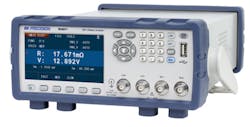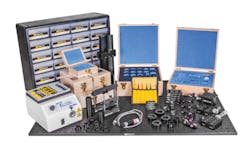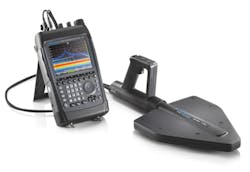Models BA6010 and BA6011 battery analyzers measure voltage and resistance of modern battery technologies with high accuracy, resolution, and speed, according to the vendor. These instruments provide auxiliary measurement of parameters including inductance, capacitance, dissipation factor, impedance, quality factor, reactance, and phase angle in degrees and radians. The BA6010 Series is suitable for characterizing battery chemistries that are responsive to a 1-kHz AC stimulus signal, including lead acid, lithium, and alkaline-type batteries used in consumer products, electric vehicles, power backup, security, and fire alarm systems. Model BA6011 supports voltage measurements of battery packs up to 300 V, whereas the BA6010 supports measurements up to 60 V and features a 6-V measurement range suitable for battery cell testing. The analyzers feature a 4.3-inch color LCD; 4-wire Kelvin test leads with fault monitoring of drive and sense lines; internal, manual, bus, and external trigger modes; a handler interface for integration with a component handler or system integration; % mode for quickly determining the percent difference between batteries; test speeds to 50 measurements per second to increase manufacturing throughput; and a compare-and-sort feature using nine bins with statistical evaluations. B&K Precision
Remote calibration
This firm has developed a new way to perform remote reading and setting of its JOFRA RTC and PTC Series temperature calibrators. A 3G Gateway unit with transmission coverage equal to a smartphone can now be attached to any JOFRA RTC or PTC temperature calibrator, and it can read data from the calibrator every two seconds. The data is presented as a real-time copy of the calibrator’s display. Once set up, a single technician can control the set point, read unit-under-test (UUT) values on a SCADA in the control room, and take the calibrator reference readout remotely, all at the same time. The JofraCloud can save time and improve work safety when calibrating sensors in difficult or dangerous locations. All set points and readings in between can be done remotely. And, during a process shutdown, when time is of the essence, the system can monitor five calibrators simultaneously on a single mobile device. On-demand reporting that sends a timestamped report at any time also is available, and the JofraCloud can send audible notification to a PC or laptop to alert the operator when the calibrator has achieved stability. Ametek Sensors, Test and Calibration
Three new kits integral to starting a new lab and keeping it stocked are offered by this vendor. Two Lab Starter Kits are available in English- and metric-based mounting versions; both feature essential products useful for any lab, from optics to detectors to cleaning and tools. The Lab Essentials Kit includes many components that are typically consumed in an optical lab or can be misplaced over time. Both the Lab Starter Kits and the Lab Essentials Kit are RoHS compliant. The kits provide 255 individual parts including a range of lenses, filters, and prisms mainly suited for the visible spectrum. The versatile Lab Starter Kits also contain two light sources: a white LED and a 640-nm coherent high-performance Stingray laser-diode module. Additional optomechanics and tools, such as stages, mounts, clamps, wrenches, and screwdrivers, as well as adapters that are compatible with the included optics, also come in the kit. A 2-channel power supply and VIS Si receiver module are also included. The kit includes cleaning supplies, tools, and basic mounting components. Both English and metric components are included, making the Lab Essentials Kit a universal kit that fulfills the needs of most labs. Edmund Optics
Battery-test device
This precision integrated analog front end, controller, and pulse-width modulator (PWM) for battery testing and formation is designed for system accuracy and efficiency in lithium-ion battery formation and grading. Compared with conventional technology, the AD8452 provides 50% more channels in the same amount of space, according to the vendor. The device uses switching technology that recycles the energy from the battery while discharging and delivers 10 times more accuracy than conventional switching solutions, the vendor says. It also enhances the safety of manufacturing processes by providing better detection and monitoring to help prevent over- and under-charging, which can lead to battery failures. The AD8452 delivers bill-of-material cost savings of up to 50% for charging/discharging boards and potential system cost savings of approximately 20%. System-simulating demonstration boards can enable lower R&D engineering cost and shorter time-to-market for test-equipment manufacturers. The AD8452 enables energy recycling battery formation/grading for systems of 20 Ah or less with up to 95% power efficiency. It offers precise measurement of current and voltage better than 0.02% over 10oC temperature change and is 70% smaller than the previous product generation, the company said. Analog Devices
A series of 13 new SMA coaxial filters consists of seven bandpass filters and six low-pass filters. The bandpass filters were developed for use in various applications including GPS, ISM, RFID, and Wi-Fi systems and operate in several bands, some as low as 824 MHz and some as high as 5.875 GHz. The new low-pass filters allow for tailoring of a test setup for a specific application and support upper-band edges of 100, 225, 400, 1,000, 2,000, and 3,000 MHz. All of these RF filters are available off-the-shelf and feature SMA female connectors. The low-pass and bandpass SMA coaxial filters are in stock and ready for immediate shipment with no minimum order quantity. Fairview Microwave
The MNT100 RF interference locator enables interference hunting in mobile networks. When unwanted transmitters are pervasive and degrade mobile network capacity and subscriber QoE, interference hunting becomes a key issue for operators and regulators. The new handheld R&S MNT100 RF interference locator uses receiver technology and intelligent processing to quickly detect, analyze, and locate even complex pulsed interference signals. The handheld instrument is optimized to detect, analyze, and locate sources of interference from 600 MHz to 6 GHz. Easy to use, it automatically locates interferers faster than existing solutions on the market by using a real-time FFT receiver and fast automatic direction finding, according to the vendor. The wide-ranging RF preselection allows the R&S MNT100 to be used with antennas in dense-spectrum environments. Under such demanding conditions, the product makes it possible to detect very low-level signals, thanks to its high spurious-free dynamic range. It also features fast real-time signal processing and, thanks to its fast gap-free real-time FFT, can detect extremely short emissions. The vendor says that signals transmitted for 20 ns can be detected with 100% probability of intercept (depending on signal level). The R&S MNT100 is available in various RF interference locator packages: a standard locator package for manu manual handheld interference hunting, an automatic locator package for automatic mobile direction finding, and the complete locator package comprising basic and automatic locator equipment. Rohde & Schwarz
Vehicle radar test system
Engineers can use the Vehicle Radar Test System (VRTS) to test 76- to 81-GHz radar technology from the R&D lab through high-volume production test and from individual radar sensors to integrated advanced driver assistance systems (ADAS). The VRTS combines the vendor’s mmWave front end technology, a PXI Vector Signal Transceiver (VST), and application-specific software. Unlike traditional automotive radar simulators that are only capable of obstacle generation for functional behavior test, the VRTS integrates a 76- to 81-GHz vector signal generator/analyzer designed for dynamic obstacle generation and comprehensive RF characteristic measurements. Using a comprehensive approach to radar test that includes both traditional and hardware-in-the-loop (HIL) test techniques, engineers can deliver robust autonomous-driving technology to comply with evolving regulatory requirements. The VRTS scales from a base configuration that can emulate two obstacles to sophisticated configurations that can emulate four independent obstacles per PXI chassis. Key VRTS attributes include the ability to simulate Doppler effect velocity of up to 250 km/hr, minimum obstacle range of 4 m, object distance resolution down to 10 cm, support for multiple angles of arrival, and variable radar cross sections. Engineers can take advantage of the flexibility of the software to use the VRTS to simulate scenarios ranging from a pedestrian walking across the street to lane-change driving scenarios. VRTS software flexibility is a key benefit of the system as engineers can easily adapt to rapidly evolving regulatory environments. National Instruments




